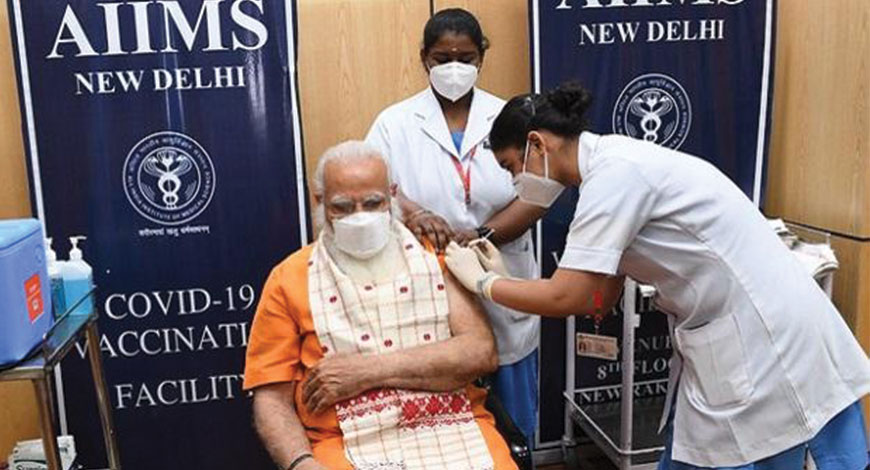Headlines of The Day
Maharashtra: Struggles on ICU beds, others fare better

Smriti Jeyur , a homemaker from Mumbai’s eastern suburbs, tested positive for Covid-19 this week. The 40-year-old had mild symptoms initially, but these escalated as the oxygen saturation in her blood dropped suddenly. Getting admitted to a nearby hospital of her choice seemed impossible and the civic body control room kept suggesting that she find hospitals with available beds. Eventually, Jeyur found accommodation close by in a 50-bed nursing home where she is on oxygen support.
Iqbal Chahal, the commissioner of the Municipal Corporation of Greater Mumbai , said on Sunday that people should set aside their personal preferences for hospitals or rooms and agree to being accommodated in beds allocated by the control room.
At Maharashtra, the epicentre of the second wave of Covid-19 in India, the health infrastructure is facing a fresh challenge as cases multiply.
The civic body in Mumbai has already operationalised 3,000 beds last week and added another 69 private hospitals on board. “These beds would not come on stream at one go. The hospitals have been asked to activate their Covid beds, and we can expect some additions every week. In total, around 200-300 new Covid beds can be added in the private nursing homes already identified,” said a civic official.
MCGM is also trying to activate 400 ICU beds within a week. As on April 5, Mumbai had only 136 ICU beds available in the city.
Rahul Pandit, head of critical care at Fortis Hospitals Mumbai and a member of the state government’s Covid task force, said: “Assuming Mumbai is adding 10,000 patients a day and only 15 per cent needs hospitalisation, that’s 1,500 daily admissions. If only 10 per cent of these patients develop severe illness, the need for ICU beds would be 150 per day. The sheer volume can pull down the city’s health infra.”
That the city hasn’t been stretched to a breaking point yet, despite the grim scenario, is down to the lack of panic among people compared to last year. In 2020, Mumbai hadn’t registered a daily caseload over 3,000. This year it has already breached the 11,000 mark.
“The demographic of the infected population is different this time. It’s more in apartment buildings than slums. Most of those infected have an option for home quarantine as a result, and people prefer home stay. It’s only the seriously ill who are seeking admission,” explained Joy Chakraborty, chief operating officer of city-based Hinduja Hospital, which is running with 100 percent occupancy of its 80 Covid beds. Hinduja is adding more Covid beds soon.
The number of fresh coronavirus cases touched a new peak on Wednesday — 1.15 lakh people. But are people across the country not panicking as much?
In Lucknow, Uttar Pradesh, Sukh – lal, 61, had been suffering from mild fever and cough for a few days. When his health deteriorated, his family members faced a harrowing time in shifting him to hospital due to a dearth of available beds. Finally, when he was admitted to a private hospital, Sukhlal was struggling with high blood glucose levels and troubled breathing. He has since been put on oxygen support.
Punjab, currently one of the worst affected sta – tes, reported 72 Covid-19 deaths on Monday — the highest spike this year. The government has ramped up facilities, including the number of Covid and ICU beds. However, people aren’t making a beeline.
Sukhjeevan Kakkar, senior medical officer of Civil Hospital in Ludhiana, said the district hospital caters to the adjoining region of Khanna, Jalandhar, Hoshiarpur, Moga and Bhatinda. In Ludhiana, there is a 100-bed facility, only 50 per cent of which is occupied. In Khanna and Vardhman with in the district, there are 50 beds each in two facilities. At both places, only one patient each is admitted at present.
V K Nagpal, medical superintendent at Government Multi Specialty Hospital in Sector 16, Chandigarh, said, “The serious Covid patients who require ventilator are just two per cent of the overall number. And the bed occupancy is negligible.”
Neighbouring Haryana has a total of 5,350 beds for Covid patients. Acco – rding to the latest data, 175 are on oxygen support and 31 on ventilators. The number of Covid beds issued far exceed the inflow of patients, according to the state health department.
Joginder Singh, a resident of Mohali who had undergone a cardiac bypass surgery in 2004, was infected in February. “Had I been infected with Covid a year ago, I would have raised an alarm. But seeing the recoveri es, I didn’t even bother my son when my wife and I tested positive. We just took multivitamins and a couple of medic i nes, and a week later we were normal,” he laughed.
Health administrators, however, are not casual as the volume of patients shows a steady and steep rise. The pressure is already visible. Maharashtra has sought oxygen supply from neighbouring states.
While the second wave is seeing less severe cases with higher infectivity, the total number of cases could be more than in the first wave. “On a higher base of affected population, the number of people requiring hospitalisation could be larger even if it is lower in percentage terms. This would put more strain on the entire hospitals’ network, both public and private. IANS














